Posted on
May 01, 2024 by
The VRG Blog Editor
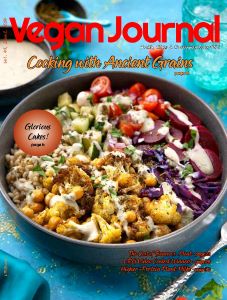
Vegan Journal is published by The Vegetarian Resource Group. Enjoy in-depth original research, product and book reviews, scientific updates on veggie nutrition, delicious vegan recipes with gorgeous photos, plus so much more. Both long-term vegans and those new to a vegan life-style will enjoy this magazine. To subscribe in the USA only, see: https://www.vrg.org/member/2013sv.php
Category
Uncategorized
Comments
0
Posted on
May 01, 2024 by
The VRG Blog Editor

By Reed Mangels, PhD, RD
The WIC (Women, Infants, Children) Program served about 6.6 million participants in 2023, including more than half of all infants born in the United States. This program was developed to protect the health of low-income pregnant and post-partum people, infants, and children up to age 5. It provides participants with vouchers that are used to purchase specific foods that are identified as being nutritious. WIC is administered by the USDA, which recently issued a press release that announced the final rule on revisions to WIC food packages. According to USDA’s website, “The changes will provide WIC participants with a wider variety of nutritious foods to support healthy dietary patterns and accommodate special dietary needs and personal and cultural food preferences. The revisions provide foods in amounts that are more consistent with the supplemental nature of the program, encourages fruit and vegetable consumption, and strengthens support for breastfeeding.”
The goals of the update include providing “additional flexibility, variety, and choice for individuals with special dietary needs due to medical conditions, limited cooking and/or storage facilities, and cultural and personal preference (including, but not limited to, vegan and vegetarian diets) while ensuring the delivery of priority nutrients to WIC participants.” Many of the changes will make it easier to follow a vegan diet while participating in the WIC program. The Vegetarian Resource Group has been promoting changes like these for many years in comments we submitted to the USDA related to WIC.
The changes will be phased in over the 24 months from the publication of the final rule, with a few exceptions.
Changes include:
- Allowing plant-based yogurt and plant-based cheese that meets requirements set by USDA for protein and calcium to be used in place of the entire allowance of dairy milk. These products would have to provide a specified amount of calcium and protein and, for yogurt, vitamin D. An added sugar limit has been established for yogurt (plant-based and dairy) and for plant-based milk alternatives. Previously, USDA had allowed “soy-based beverages”; now “plant-based milk alternatives” are allowed. Medical documentation is not needed to substitute plant-based products for dairy milk. I’ll talk more specifically about these important changes in a future blog post.
- Reducing the maximum monthly amount of dairy milk allowed.
- Requiring that tofu, which can be used to replace dairy milk, supply at least 100 milligrams of calcium per 100 grams of tofu.
- Requiring states to allow peanut butter and legumes to substitute for eggs. Allowing states the option of substituting tofu for eggs. Previously, WIC regulations did not allow substitutions for eggs.
- Requiring canned beans to be offered in addition to dried.
- Allowing WIC State agencies the option to authorize nut and seed butters as a substitute for peanut butter.
- Reducing the amount of infant meat (baby food meat) offered for breast-fed babies.
- Expanding whole grain options to include quinoa, wild rice, millet, triticale, amaranth, kamut, sorghum, wheat berries, tortillas made with folic acid-fortified corn masa flour, cornmeal, teff, and buckwheat. Whole wheat pita, English muffins, bagels, and naan were also added as whole grain options. In addition, WIC State agencies are allowed to authorize other whole grain options that meet WIC standards.
- Permanently increasing the fruit and vegetable benefit so that the dollar amount of vouchers to purchase fruits and vegetables increases up to 4-fold.
- Requiring that WIC State agencies allow fresh and at least one other form (canned, frozen, dried) of fruits and vegetables.
- Allowing fresh-cut herbs to be purchased with vegetable vouchers.
These changes will potentially make the WIC program more relevant to vegans as well as promoting more plant-based options for all participants.
To read more about the WIC program see:
The Vegetarian Resource Group Sent in Testimony on the Proposed Revision in the WIC Food Package (2023)
USDA Proposes Updates to the WIC Program (2022)
WIC Programs Offer Foods For Vegans (2020)
WIC Farmers Market Program (2020)
Revisions to the WIC Food Package Make Sense (2014)
Category
Uncategorized
Comments
0
Posted on
April 30, 2024 by
The VRG Blog Editor
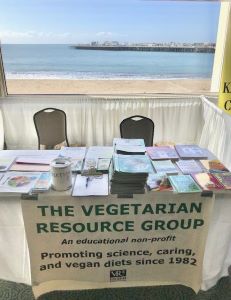
Special thanks to Arnie Alper, MD for staffing The Vegetarian Resource Group booth at the Santa Cruz VegFest in California. Over 3,000 people attended this successful event! Shout-out as well to VRG’s Nutrition Advisor, Reed Mangels, PhD, RD, who co-coordinated over 74 volunteers that helped make this event happen.
Category
Uncategorized
Comments
0
Posted on
April 30, 2024 by
The VRG Blog Editor

Cheyenne writes: I became vegan when I was around 14 years old. For the past two years I have been working on a campaign advocating for plant-based Meals-Ready-To-Eat for military personnel. I have spent numerous hours speaking to political and military leaders about the importance of integrating a humane food option for military personnel. On top of this, as President of my school’s Environmental Club, I have actively promoted plant-based eating and veganism. I spoke to a school board member about the need for more plant-based options in Arlington Public School cafeterias. I have also created and presented a short documentary about the need for the United States to move away from its reliance on animal agriculture. At the organization Center for Youth and Family Advocacy workshop, I spoke about the importance of eating more plants and the benefits, including lower blood pressure, other heart-healthy benefits, and increasing fiber intake. Being vegan is not a trend or hobby. Being vegan is who I am and the ethical guide I follow to live a life I deem morally sound.
The most difficult challenge I have had to overcome was surgery due to cancer. In addition to the anxiety with a fear of reoccurrence, the surgery itself impeded me from doing the sport I love—weightlifting. My greatest successes include being a vegan who is a competitive weightlifter, going to states for track and field, and becoming a certified personal trainer.
We asked Cheyenne how she responds to other weightlifters who tell her that she needs to have animal protein. She related: This comes up quite often. Typically, when I tell other lifters I am vegan, they look at me funny and ask, “How do you get your protein, though?” ME: “I get my protein from plants. How do you think the animals you eat get their protein?” THEM: They almost always say, “Plants, I guess.” ME; “Exactly, I just don’t eat the middle man.” I believe I can serve as a role model for America’s youth—as they will see and learn that a physically strong woman thrives as a vegan.
I will promote veganism in the college I am going to attend, the University of Virginia (UVA), by reviving the UVA Vegan Club and pushing to create a more humane campus. I will also use my degree and education to implement policy changes and work to further animal rights through politics and policy. I hope to get my law degree or a Master’s in Public Policy to learn the tools necessary to become an effective activist and advocate.
Support Young Veg Activists
To send support for additional scholarships and internships, donate at www.vrg.org/donate or call (410) 366-8343. You can also send a donation to VRG, P.O. Box 1463, Baltimore, MD 21203.
Do you know an amazing vegan or vegetarian high school student? If so, let them know about our annual scholarship contest. The deadline for high school seniors is February 20th of each year. To see scholarship rules and past winners, visit www.vrg.org/student/scholar
Category
Uncategorized
Comments
0
Posted on
April 29, 2024 by
The VRG Blog Editor
 Some vegans may end up in an assisted-living facility sometime during their life. How can you make sure that your vegan diet/lifestyle is accommodated? Chef Nancy Berkoff shares tips that can be shared with the assisted living establishment, as well as recipes that can be used. See: https://www.vrg.org/journal/vj2012issue4/2012_issue4_assisted_living_food_service.php
Some vegans may end up in an assisted-living facility sometime during their life. How can you make sure that your vegan diet/lifestyle is accommodated? Chef Nancy Berkoff shares tips that can be shared with the assisted living establishment, as well as recipes that can be used. See: https://www.vrg.org/journal/vj2012issue4/2012_issue4_assisted_living_food_service.php
Category
Uncategorized
Comments
0
Posted on
April 29, 2024 by
The VRG Blog Editor
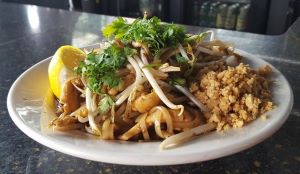
Summer Pad Thai photo
Where: Sawatdee Thai Restaurant, Minneapolis, Minnesota
When: Sunday, October 6, 2024, 6 PM
Come meet dietitians from the Vegetarian Nutrition Dietetic Practice Group as well as VRG members. The public is invited. You must preregister. You can pay at www.vrg.org/donate and write in the names of attendees and that this is for the Networking dinner.
BUFFET
Appetizers: Vegetarian Spring Rolls and Fried Tofu
Main Dishes:
Red Curry with Tofu
Summer Pad Thai
Combination Vegetable Dish with broccoli, cauliflower, mushrooms, onions, napa, water chestnuts, tomatoes, and mock duck.
Plus: Brown Rice and White Rice and Coffee or tea and water
Dessert: Mango and Sticky Rice
Cost: $30 for VRG and Vegetarian Nutrition Practice Group members before September 15, 2024. $35 for others. $20 for two to ten year olds. Other drinks can be purchased from the restaurant separately.
PLEASE PAY at www.vrg.org/donate and write in the Comments: Networking Dinner with the Attendee names. Or call (410) 366-8343. Or mail payment to The Vegetarian Resource Group, P.O. Box 1463, Baltimore, MD 21203. We look forward to seeing you there.
Category
Uncategorized
Comments
0
Posted on
April 26, 2024 by
The VRG Blog Editor
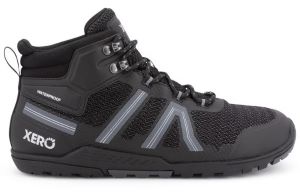
Xero Shoes Xcursion Fusion Hiking Boots – Men’s REI Co-op
Enjoy the outdoors: you may want to go hiking in the USA, Canada, and/or Europe. Below is a list of online stores offering vegan hiking boots and shoes.
Avesu Vegan Shoes out of Germany sells Lowa hiking boots and shoes. See: https://www.avesuveganshoes.com/brands/lowa-com.html
Eco Vegan Shoes out of the Netherlands offers vegan hiking shoes and boots. See: https://www.eco-vegan-shoes.com/vegan-hiking-boots-walking-shoes
Ethical Wares out of Wales in the United Kingdom offers a wide variety of hiking boots See: https://www.ethicalwares.com/footwear/walking-boots-and-shoes/
Merrell in the USA offers some vegan hiking shoes. Search under “vegan hiking shoe or boot.” See: https://www.merrell.com
REI offers several vegan hiking shoes and boots. Search under “vegan hiking shoe or boot.” https://www.rei.com/
Thesus headquartered in Toronto, Canada and will ship hiking shoes for women to Americans. Search under the word vegan boot. See: https://thesusoutdoors.com/
Treksta USA offers hiking shoes and boots for men and women. See: https://trekstausa.com/product-category/vegan
Will’s Vegan Store in London, England offers hiking boots for men and women. See: https://wills-vegan-store.com/
Category
Uncategorized
Comments
0
Posted on
April 26, 2024 by
The VRG Blog Editor
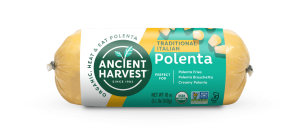
photo from Ancient Harvest
Chef Nancy Berkoff shares both savory and sweet dishes featuring polenta here: https://www.vrg.org/journal/vj2011issue3/2011_issue3_vegan_cooking_tips.php
Subscribe to Vegan Journal in the USA only here: https://www.vrg.org/member/cabdacae.php
Category
Uncategorized
Comments
0
Posted on
April 25, 2024 by
The VRG Blog Editor

photo from La Vimea
- 3 Place des Arbes (B&B in Felletin, France)
- Andean Spirit Lodge – Limatambo (vegetarian guesthouse with vegan options; Cusco, Peru)
- Appalachian Trail Adventures(Killington, VT, US)
- Beck Hall (vegan hotel located in the Yorkshire Dales in England)
- Black Sheep Inn (vegan Inn in Hammondsport, NY, US)
- Brookton Hollow Farm Bed & Breakfast (near Ithaca, NY, US)
- Carmel Valley Lodge (Carmel Valley, CA, US)
- Casa Albets (Vegan hotel Lelida, Spain)
- Deer Run on the Atlantic (vegan B&B in Big Pine Key, FL, US)
- Farm Sanctuary Cottages (vegan and part of Farm Sanctuary in Watkins Glen, NY, US)
- Finca de Vida (vegetarian health lodge & healing center with vegan options in Costa Rica)
- Ginger Cat Bed & Breakfast (vegan B&B in Rock Stream, NY, US)
- Harvest Moon Bed & Breakfast (vegetarian B&B with vegan options in Rutland, VT, US)
- Haskell’s House (vegetarian guest house with vegan options in Ft. Lauderdale, FL, US)
- Haus Sonnenstein Bed & Breakfast (vegetarian B&B with vegan options in Germany)
- The Homestead at Catskill Animal Sanctuary (vegan guest house in Saugerties, NY, US)
- Kingston House Bed & Breakfast (B&B with vegan options in Bermuda)
- Koukoumi Hotel (vegan hotel in Greece)
- La Maison Du Vert (vegan guest house in Paye D’Auge, France)
- La Vimea (vegan hotel in Italy)
- Lands in Love (vegan hotel in Costa Rica)
- Le Cheval Blanc(vegan B&B in St Antonin-Noble-Val, France)
- Mikasa boutique Hotel (vegan hotel located in Spain)
- Mother Earth Vegan Hotel (vegan hotel located in Costa Rica)
- Omassim Guesthouse (vegetarian guest house with vegan options in Ericeira, Portugal)
- Park Lane Guest House(vegetarian guest house with vegan options in Austin, TX, US)
- Red Robin Song Guest House (vegan guest house in Lebanon, NY)
- Saorsa 1875 Hotel (vegan hotel in Scotland)
- Sewall House Yoga Retreat (vegetarian with vegan options in Island Falls, ME, US)
- Speedwell Forge B&B (B&B with vegan options in Lititz, PA, US)
- The Stanford Inn by the Sea (vegan hotel resort in Mendocino, CA, US)
- Sugar Ridge Retreat Centre (vegetarian center with vegan options in Ontario, Canada)
- Sundogs Bed and Breakfast (vegan B&B in Shepherdstown, WV, US)
- Topia Inn(Inn with vegan options in Adams, MA, US)
- Vegan Agrivilla i Pini (vegan hotel located in Italy)
- Volcano Eco Retreat by Heart Core Hotels (vegan hotel located in Hawaii, USA)
- The White Pig Bed & Breakfast at Briarcreek Farm (vegan B&B at pig sanctuary in Schuyler, VA, US)
Category
Uncategorized
Comments
0
Posted on
April 25, 2024 by
The VRG Blog Editor

Former VRG intern Julia Mathew shares vegan South Indian recipes that were passed down through generations and are finally in written form for everyone to enjoy! Try Kerala Parippu Curry (South Indian Lentil and Coconut Dish), Sambar and Dosa (South Indian Lentil and Vegetable Stew with a Sourdough Crepe), Masala Dosa (South Indian Potato and Vegetable-Filled Crepes), Thenga Chammanthi (South Indian Coconut Chutney), and Cherupayar Ularthiyathu (Kerala Mung Bean Stir-Fry).
The article can be found here: http://www.vrg.org/journal/vj2018issue1/2018_issue1_recipes_coconuts.php
To subscribe to Vegan Journal, visit: Subscribe to Vegan Journal
Category
Uncategorized
Comments
0










